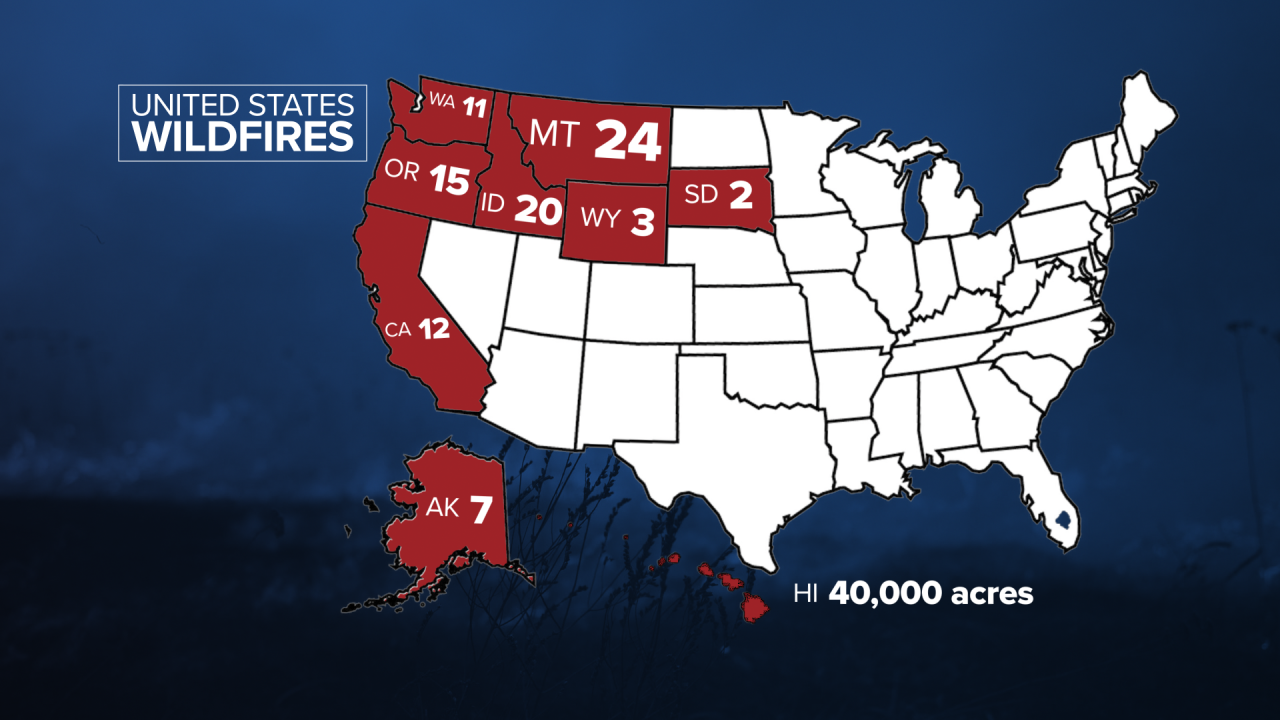HELENA — The Rock Creek Fire just north of Wolf Creek raged in grass and timber forcing evacuation in the area before being contained on July 10. The fire scar it left and others like it are unfortunately a common sight in the western United States this year.
As of Thursday, 100 large active wildfires were burning across the country. Montana is the most active with 24, followed by Idaho with 20, Oregon has 15, California has 12, Alaska and Washington have 11 each. There was even a 40,000-acre wildfire burning in Hawaii this week. One of the largest to be reported in that state.
No one agency has enough resources to handle the modern fire seasons that the United States is seeing. The National Interagency Fire Center (NIFC) and its subsets are the solution to addressing those needs. For Montana, the Northern Rockies Coordination Center (NRCC) manages and assigns resources.

There have been more than 50 resource requests through NRCC unfulfilled in recent weeks because there just isn’t the help available right now that teams require.
“The thing that’s really hamstringing us the last few years is that all of the western states have been active at the same time So we haven’t been able to share as many resources across state boundaries because we’ve all be active at the same time,” explained Aaron Thompson, Bureau of Land Management Montana/Dakotas' Fire Management officer.
Thompson says historically northern-based firefighters would head to southwestern wildfires earlier in the year. Then once the south’s fire season would calm down, the southern-based teams would return the favor by sending resources up north.
However, in recent years those regions have continued to burn with large wildfires all at once. Crews from other regions of the country want to help Montana but are needed battling fires in their area.
While 2021 has not been abnormal in total acres burned across the country, it is abnormal is how early large wildfires were reported in the northern states.
Incidents are also showing historic fire activity and energy release due to how dry conditions have been this year. When fire a starting now, they're often quickly growing in size and intensity.
One of the first large wildfires reported this year was in the Dakotas near Lemmon, SD. The January fire burned nearly 20,000 acres. Because of the lack of snow this winter, the dead grasslands were exposed.

“That was driven by the drought conditions we’re seeing, and the drought continues to intensify. And then the unprecedented weather that we’ve been seeing this summer in Montana and Idaho with temperatures in the triple digits for days on end,” said Thompson.
Similar to the states’ agreement, the U.S. has mutual aid agreements with Australia and Canada to provide resources when a fire season because too much for native teams to handle.
Fire crews MTN has spoken with over the years often talk fondly about working with their international counterparts. However, Canada is experiencing the same issues right now as the U.S. and doesn’t have resources to spare.
According to NIFC, more than 3.3 million acres have burned so far across the county in 2021 as of Aug. 5. It’s a similar situation up north, with Canada seeing 3.2 million acres burned.
British Columbia is experiencing one of its worst fire seasons in the past 70 years, seeing 1.3 million acres burned in the providence alone as of Aug. 5.

“Canada for the last several years has had very busy fire seasons. This year in British Columbia alone they set the all-time high record temperature of 124 degrees.,” said Thompson. “Those firefighters up there, they have the same values at risk (as Montana). They have large population centers among forested lands.”
NRCC says the unfortunate truth about what happens when fire suppression resources are low is prioritization has to take place. People’s safety, homes and infrastructure are always on the top of the list.
A 1,000-acre fire may have two to three times the number of personnel assigned if homes are threatened compared to a 10,000-acre fire is burning in the middle of federal land away for any town.
Australian resources are currently helping in the United States, but the majority have been assigned to help fight Canadian fires that are threatening lives, property and other critical assets.
Another issue NRCC is contending with this year is firefighter fatigue.
“We have recognized early on this fire season, that starting this early, that its really a marathon, not a race. We have got to manage fatigue of our firefighters,” said Thompson.
Crews have mandatory downtime to help prevent exhaustion but the earlier the fire season, the more of a burden it is on those men and women.
Montana has activated the National Guard to help with fire suppression efforts, with 200 expected to be active by the end of the week. While they are a valued resource right now, the truly needed calvary is mother nature. It’s only the first week of August, however, and it will still be quite a while before snow is on the ground.
-
Be Prepared: Evacuation Tips
Helpful tips and suggestions should you need to evacuate due to a wildfire -
Wildland Fire Terminology 101
Search common terms used in wildland firefighting and reporting to better understand what is happening during a fire. -
Fire Restrictions in Montana
View a map showing current fire restrictions in across Montana. -
Wildfire Watch: Submit Your Photos
Click here to share your photos or videos with MTN News.




